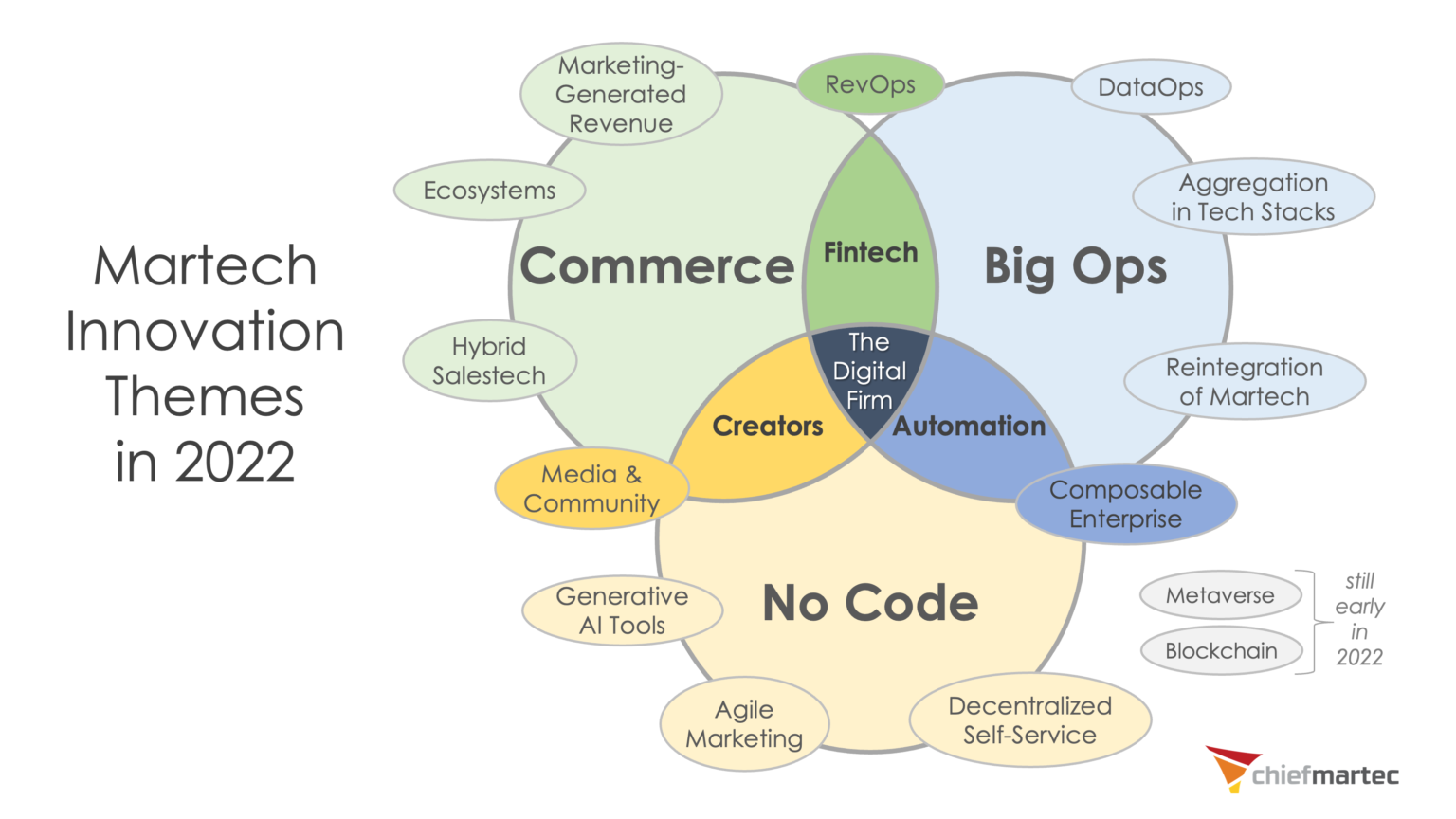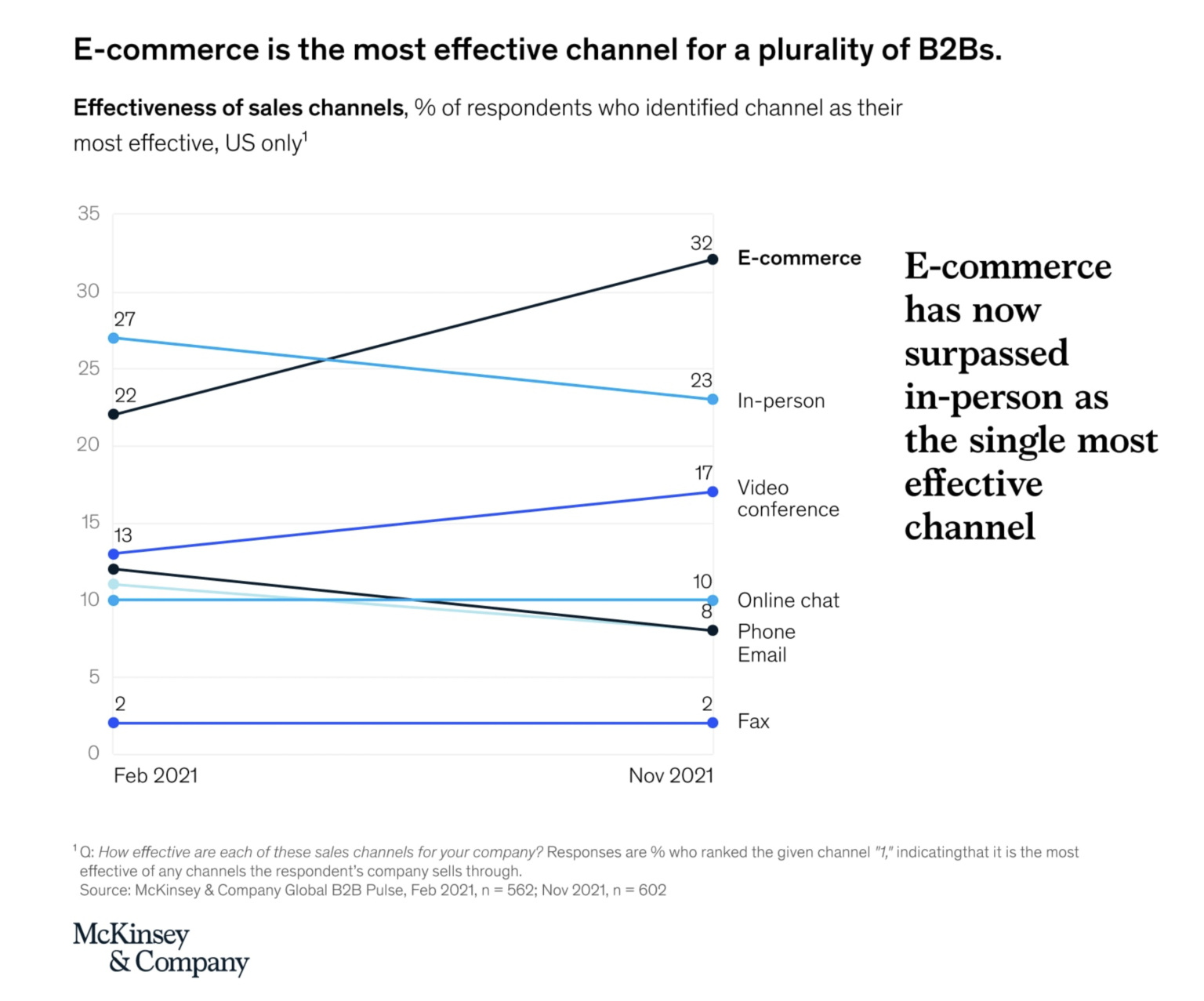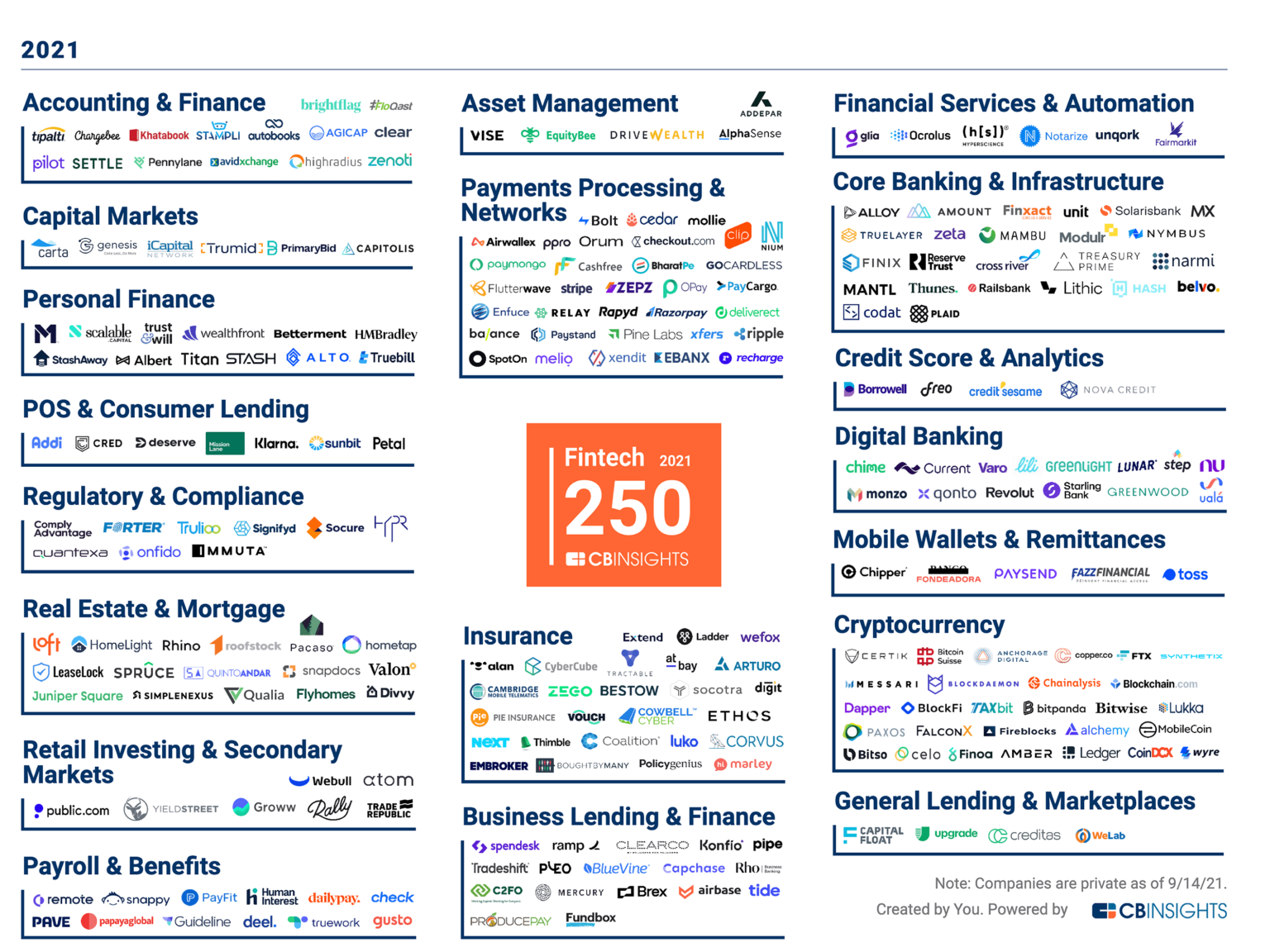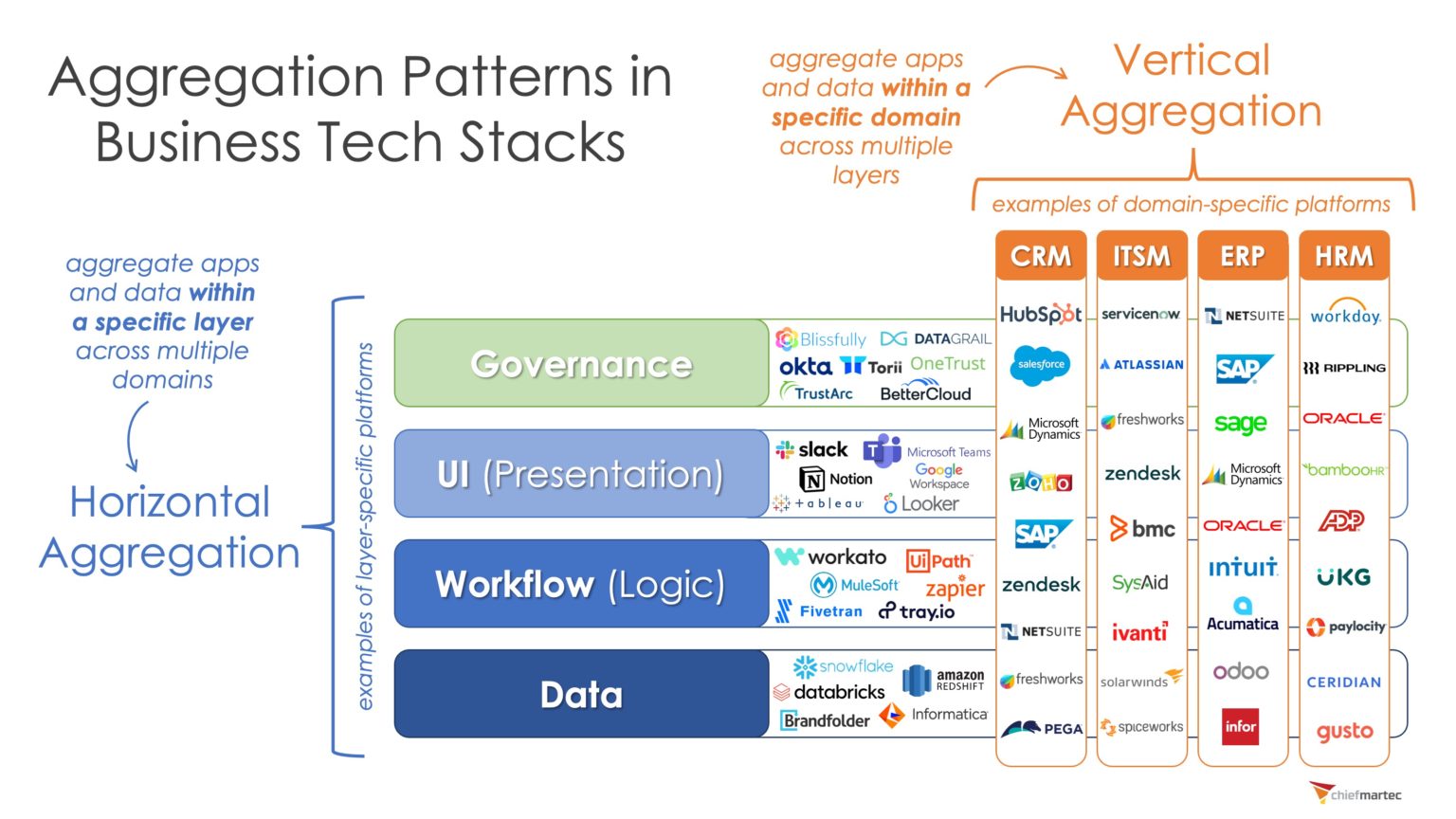
Hello, 2022! Or document.write("Hello, 2022!") to those still in codeland.
Following my wrap-up of martech from 2021 — tl;dr a year in digital marketing that was experienced like a Twitch stream at 1.5X speed — let’s jump in to the martech topics I expect will shape 2022.
Now, it’s true, I’m generally quite skeptical of “predictions” and therefore reluctant to label this post as such. But since I spend my days deep in martech — long past 10,000 hours at this point — I’m happy to share the themes I see gaining momentum in our field. These are the areas I personally plan to pay close attention to in the year ahead.
As illustrated above, I see three big themes for new martech innovation in 2022:
- Commerce, both B2C and now B2B, with more in marketing’s domain
- Big Ops, the rapid evolution of process and technology in a digital firm
- No Code, superpowers for non-technical and semi-technical marketers
I picture them in a Venn diagram, with intersections featuring fintech (Commerce + Big Ops), automation (Big Ops + No Code), and creators (No Code + Commerce). Together, these forces are converging into The Digital Firm.
What exactly is “The Digital Firm” you ask? It’s life after digital transformation.
Martech Big Theme #1: Commerce
The pandemic massively accelerated ecommerce, catapulting both the Amazon Empire and the Shopify Rebel Alliance to new highs. For consumers, online purchasing became the preferred — and at times the only — channel for nearly every category of spending. A wave of B2C-centric martech innovation ensued and is still accelerating in areas such as social commerce and so-called “super apps” (which are more super in the East than the West).
But a less appreciated commerce revolution is rising rapidly in B2B now too.

The above chart from a McKinsey article on trends in B2B sales shows that e-commerce is now viewed as the most effective channel for B2B sales. Additional data in that report shows that digital self-serve is now the most popular way for B2B buyers to make their purchases at every stage of the sales journey: identifying and researching new suppliers (37%) considering and evaluating new suppliers (34%), ordering (37%), and reordering (38%).
Slightly less preferred are “remote human interactions” — e.g., video-conferencing, online chat, email, phone — for researching (32%), evaluating (34%), ordering (32%), and reordering (33%). Taken together, about 2/3 of B2B buyers now opt for remote interactions or digital self-serve.
And 35% of them are willing to make $500,000+ purchases for a new product or service either remotely or via digital self-serve.

This has a ton of implications for marketing and martech, but perhaps the greatest is the opportunity for direct Marketing-Generated Revenue. While marketing has long sought to reframe itself as a revenue engine rather than a cost center, its claim to that mantle has been debatable in most sales-driven organizations. Great progress has been made in attribution analytics over the past five years, but for sheer respect in the C-suite, nothing beats being the one who closes the sale and takes the money.
With digital self-service buying, however, marketing can create campaigns and digital experiences that directly embed transactions. This has been the case in consumer e-commerce and direct-to-consumer (DTC) businesses for a while. But now, it’s coming to B2B. For marketers — and the martech and marketing ops teams who support them — this opens up whole new worlds of possibilities. I expect a lot of experimentation here, powered by new and updated commerce-enabled martech tools.
Another commerce-related theme that will be big for marketers is Ecosystems. In the latest IBM C-Suite study, operations-focused CEOs at high-performing companies ranked “Build new ecosystems and partnerships” as their top priority (48%) for building customer experience and trust over the next 2-3 years. (Underperformers ranked it last, at 24%.)
Ecosystems are more than just a channel: “Vendors have shifted from a ship and forget model to having a maniacal focus on customer experience and lifetime value. In the process, a diverse ecosystem of customer value influencers and contributors have emerged.” Anyone who has a relationship with your buyer, whether offering a complementary product, service, community, or influencing advice becomes part of your ecosystem.
Allan Adler, who wrote that last piece, suggests that companies evolve beyond go-to-market thinking to a more holistic go-to-ecosystem worldview. And the category of channel-related — or more broadly, ecosystem-related — marketing and sales technologies, shown in this landscape map from Jay McBain, continues to expand to support these activities.

The final commerce-related theme that I’ll highlight is Hybrid Salestech. The salestech landscape has been growing at an exponential rate over the past couple of years — I’ve said a few times that salestech is the new martech. The shift to remote interactive sales and digital self-service sales has been major catalyst for this, and we’re still in the early innings of that overhaul.
“Hybrid” sales roles — that leverage a blend of digital and remote interactions directly and through marketing-built touchpoints — is the fastest growing segment on B2B sales teams. (70% growth according to that earlier mentioned McKinsey report.) And it’s driving adoption of new, upgraded, or replaced salestech products.

It’s also increasing the overlap in technology and operations between marketing and sales — opening up terrific opportunities for martech professionals to bring greater value to both organizations.
Martech Big Theme #2: Big Ops
The growing diversity of digital commerce is one contributor to the theme of Big Ops.
Just as Big Data was about the volume, velocity, and variety of data flowing through our organizations, Big Ops is about the volume, velocity, and variety of all the digital operations now running on top of that data: the explosion of apps, agents, algorithms, analyses, and automations and executing in parallel across our organizations.
One way Big Ops has manifested itself is in the growth and proliferation of “ops” roles:

While each of these roles has their own domain expertise, they all share similar DNA in wrangling data and processes through apps and automation.
Core to the current revolution in commerce, Fintech give us a kaleidoscope of new apps and digital services around finance, rivaling the scale of the martech landscape when it was at a similar stage. It’s remaking every facet of how, when, and where payments are made and received by companies in digital ecosystems. In the process, it’s catalyzing major changes in finance ops and business ops — entangling them in more closely customer experience.

Fintech is also contributing to the rise of RevOps — revenue operations — as an umbrella ops function that connects the dots across marketing, sales, customer service, and finance. Quote-to-cash, more broadly lead-to-cash, flows across all these teams. To optimize those flows and to make them more agile and adaptable, those teams be aligned on everything from data definitions to SLAs. RevOps provides that coordination while elevating an end-to-end management of the full customer journey.
The most exciting developments in Big Ops are, like RevOps, organizational efforts to connect these different ops domains and bring greater cohesion to The Digital Firm as a whole. Another major example is DataOps, which brings a common architecture and set of processes and practices for collecting, organizing, and applying data across all departments.
Marketing ops teams should embrace this broader DataOps ecosystem. Marketing has tons of valuable data that it can contribute to this ecosystem, enriching the analytics and models that other teams leverage. But even more so, marketing can benefit tremendously from tapping into the vast wells of customer data that other teams contribute from product, distribution, customer support, accounting, field operations, etc.

This data is a bounty of behavioral insights and “marketable moments.”
DataOps is also an excellent example of the Reintegration of Martech — the shift underway to move from a “martech stack” that is largely siloed in the marketing department to a “business stack” that spans the entire enterprise. Moving beyond just The Digital Marketing Department to The Digital Firm.
Of course, there will still be plenty of marketing-specific apps. And marketing will extend shared app infrastructure with its own customizations and domain-specific functionality. But the underlying platforms and ecosystems will be bigger than any one department.
Let me emphasize: this is not a reduction in the power and importance of martech and marketing operations. On the contrary, this is a dramatic expansion of the scope of scale of the work martech and marketing ops professionals can engage in, working beyond the walls of classic martech.
Think bigger with Big Ops.

The reintegration of martech is being enabled by a shift in product philosophy happening in the SaaS market today. While vendors have always been striving for consolidation in their category — as long as they were the consolidator, not the consolidatee — many have now realized that fighting the trend of software proliferation in the world is like building sand castles against an incoming spring tide.
Instead, more and more big players have shifted to a strategy of Aggregation in Tech Stacks, channeling the rising tide of apps into common platforms either for a specific layer of the business tech stack (horizontal aggregation) or within a specific domain (vertical aggregation).
Aggregation is different than consolidation because it’s not attempting to get rid of all the other apps in your stack. Just the opposite: it aims to let you get more value out of growing app diversity by aggregating — and therefore standardizing and making interoperable — data, workflow, UI, and/or governance across all those apps. (Those aggregation platforms, however, remain in an increasingly intense battle for market consolidation over who will be the lead aggregator in their layer or domain.)
Major DataOps vendors such as Snowflake and Databricks offer quintessential examples of this aggregation strategy at the data layer.
Another example of aggregation theory in tech stacks is with Automation. Thanks to open APIs, there’s a wave of cross-app and cross-team automation happening in The Digital Firm. Automation is really at the heart of Big Ops, and it’s about more than efficiency. We’re just starting to tap the higher-order effects of orchestration and innovation that highly malleable automation platforms enable.
Gartner has captured the essence of malleable infrastructure with their concept of The Composable Enterprise. This is effectively the Lego-ization of software, letting businesses rapidly assemble specific apps and digital experiences from a set of interoperable components.

Again, martech and marketing ops teams are both contributors to and beneficiaries of the Composable Enterprise. You can build more, more quickly, with greater customization. And the components you build can, in turn, be leveraged by other teams, integrating marketing beyond the walls of the marketing department.
Martech Big Theme #3: No Code
Which segues perfectly into our third big theme: No Code. I interpret “no code” broadly as any technology that lets general business users — in our cases, marketers — self-service work that would have previously required them to turn to an expert to deliver. This includes building web pages, workflows, data analyses, creative assets, and, of course, anything that you might think of as “app” for internal or external consumption.
Collectively, no code is the yellow sun that imbues us with marketing superpowers.

It’s not that no-code eliminates experts. But rather it leaves the high-end use cases for those experts, while making low-end use cases accessible for marketers to address on their own, anytime they want, with fewer delays, bottlenecks, and resource constraints.
Workflow automations — of which there’s a ton in marketing ops and RevOps — are a terrific example of Decentralized Self-Service capabilities enabled by no-code technology. Recent survey data from no-code vendor Tonkean shows the empowerment of business teams to build some, if not all, of their own automated workflows is becoming an accepted norm.

By eliminating delays and bottlenecks for a larger set of the ideas that marketing wants to implement, no-code tools accelerate the clockspeed of marketing overall. The Theory of Constraints then shifts our focus from technological barriers to organizational ones: how can we structure and manage marketing to move faster? This will drive further adoption of Agile Marketing practices.
Some of the most interesting no-code innovations will be with Generative AI Tools that will help marketers create sophisticated digital assets just by describing what they want. For instance, the field of AI content generation is blossoming. As just one example, consider Synthesia, which lets you magically create a natural-looking and -sounding — yet artificially generated — spokesperson video just by typing in a script.
Combine that with the ability to automate and orchestrate such generative AI tools across an ever-more-connected Big Ops environment, and if your imagination isn’t running wild with all the new possibilities this will unlock in marketing, you should check your pulse.
In this future (present) business environment that Gartner described (and I annotated) in the below graphic, I think the most significant change is what they call the emergence of top-tier employees — which I would reframe as the rise of in-house Creators.

There’s an incredible boom underway with The Creator Economy for individuals and entrepreneurs operating outside the walls of large organizations. But the same mindset and skillset can be harnessed inside businesses too.
The reworking of “work” with flatter, faster organizations and the empowerment of individual employees with no-code tools form an “Axis of GSD” — an environment for people to Get Stuff Done with much greater speed and independence, even in big companies.
In marketing, the growing popularity of owned Media & Community initiatives provides an ideal opportunity for these in-house creators to shine. Which poetically loops back into the theme of commerce-related innovation bubbling up in these new channels.
Martech Theme Omissions for 2022
While there’s no lack of grand prognostications around the ideas of the Metaverse and Blockchain-powered Web3 concepts, in my opinion these are still early for mainstream martech. Unless you’re in the gaming or crypto business, I don’t think these will play a significant role in your marketing operations in 2022.
Super interesting stuff, and worth keeping an eye on for the future.
But given our three big themes above — Commerce, Big Ops, and No Code — that here in full-force today — we’ve got more than enough to tackle. It’s going to incredible 12 months ahead in martech. Let’s dive in!



